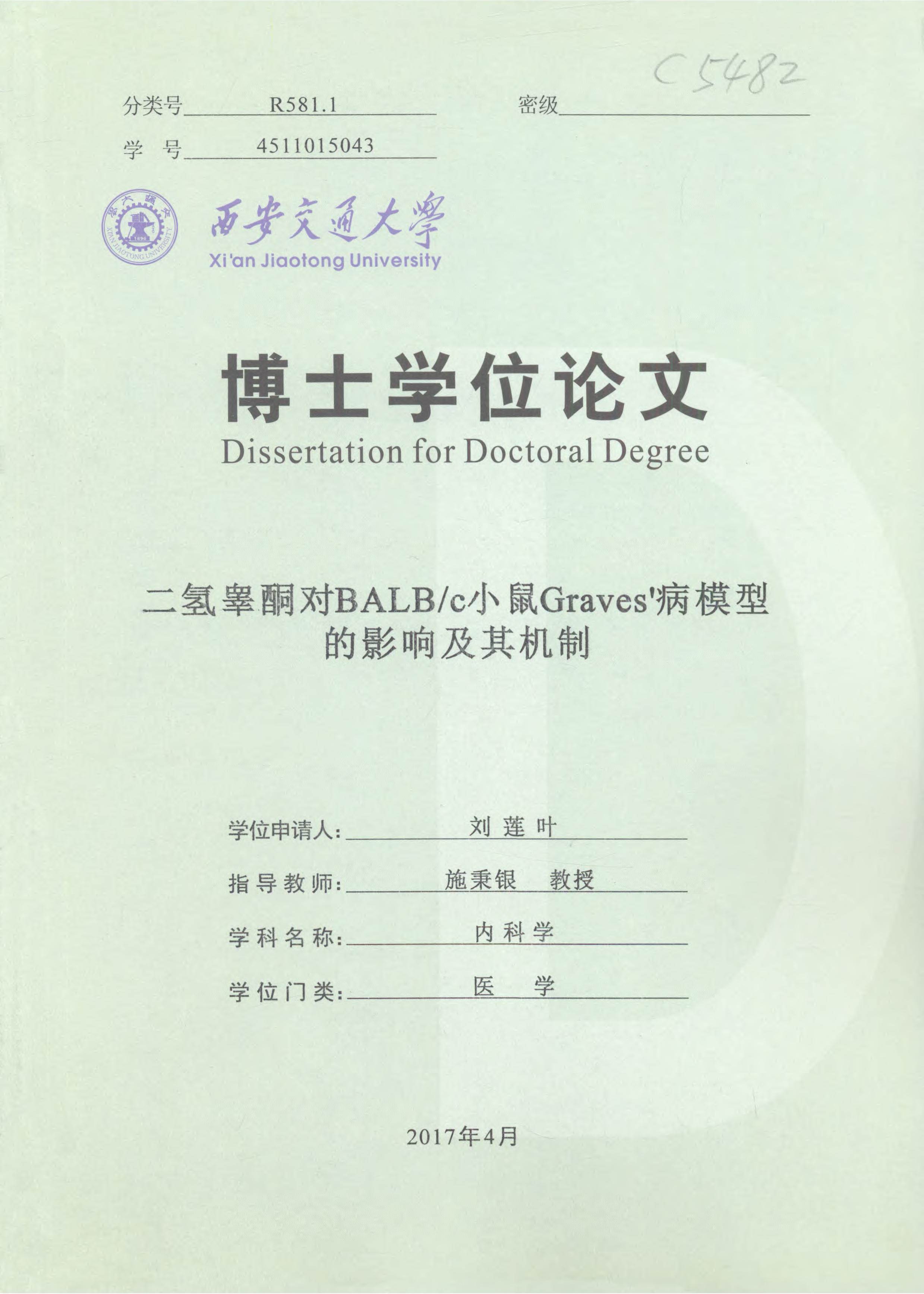
目的: Graves'病(Graves'disease,GD)是一种常见的以甲状腺功能亢进为特征的器官特异性自身免疫性疾病,它在患病率和临床特征方面均表现出明显的性别差异,性激素在GD的发病中发挥着重要的作用。异常的淋巴细胞因子生成以及T淋巴细胞活化可能导致GD患者出现各种不同的临床表现。共刺激分子参与了自身免疫性疾病的发生发展,在自身免疫反应的调节中发挥着关键的作用。在对自身免疫性疾病患者及动物模型的研究中,发现了雄激素对自身免疫的抑制作用,但是雄激素对GD的治疗作用及其机制仍旧不清楚。因此,我们对一个具有生物活性的雄激素二氢睾酮(5α-dihydrotestosterone, DHT)进行了 研究,旨在发现 DHT 是否在 BALB/c 小鼠 GD模型中发挥着一定的自身免疫抑制作用。该研究的主要目的包括以下两个方面:a)DHT预处理是否可抑制自身免疫反应;b) DHT在BALB/c小鼠GD模型中的自身免疫保护机制。 方法: 用腺病毒表达的人促甲状腺素受体抗体A-亚单位(thyroid stimulating hormone receptor A-subunit, Ad-TSHR289)免疫BALB/c小鼠3次。在免疫前1 w分别皮下植入3种不同剂量的DHT (1.5、5及15 ㎎)或其对应剂量的安慰剂。第三次免疫后4w处死小鼠,收集其血液、脾脏、胸腺及甲状腺组织进行分析。检测小鼠血清促甲状腺素受体抗体(thyrotrophin receptor antibodies,TRAb)、总甲状腺素(total thyroxine,TT4)、游离甲状腺素(free thyroxine,FT4)水平,计算甲状腺刺激性抗体结合抑制指数(thyroid stimulating hormone-binding inhibition, TBI)值。用HE染色观察小鼠甲状腺组织变化。用流式细胞仪分析小鼠脾脏T辅助细胞(T helper cells,Th) 1、Th2、Th9、Th17淋巴细胞分泌相应细胞因子的细胞百分比。用实时定量PCR检测对比小鼠脾脏及胸腺淋巴细胞表面的共刺激分子:包括细胞毒性T淋巴细胞相关抗原-4 ( cytotoxic T-lymphocyte-associated protein 4,CTLA-4)、B、T 淋巴细胞弱化子(B and T lymphocyte attenuator, BTLA)、程序性死亡因子-1 (programmed death-1, PD-1)、T 细胞免疫球蛋白黏蛋白分子-3 (T-cell immunoglobulin domain and mucin domain 3,TIM-3 )、CD28、可诱导共刺激分子(inducible T-cell costimulatory,ICOS)、OX40 (CD134)及 CD154(CD40 配体)的信使 RNA (message RNA,mRNA)的表达。 结果: BALB/c小鼠经过Ad-TSHR289免疫3次构建成实验性自身免疫性GD模型,该模型小鼠的血清TBI阳性率达到100%,而且其血清TT4及FT4水平与健康对照组相比显著升高。经过DHT处理的雌性小鼠血清TT4及FT4水平显著降低,TBI值虽然有下降趋势,但尚未达到显著性统计学差异。用流式细胞仪检测小鼠脾脏淋巴细胞因子发现,雌性小鼠DHT治疗组的分泌Th1细胞因子干扰素-γ(interferon-γ,IFN-γ)及白细胞介素-2 (interleukin-2, IL-2)的淋巴细胞百分比与安慰剂组相比明显降低;三种剂量DHT预处理后,雄性小鼠DHT组分泌细胞因子白细胞介素-10 (interleukin-10,IL-10)的淋巴细胞百分比与对应安慰剂组相比显著升高。经过Ad-TSHR289免疫后的雌性小鼠GD模型脾脏PD-1的mRNA表达下调、脾脏与胸腺TIM-3的mRNA表达下调、脾脏CD154的mRNA表达上调及胸腺ICOS的mRNA表达上调。经过DHT 5㎎处理后,治疗组雌性小鼠脾脏的PD-1的mRNA表达增加、小鼠脾脏及胸腺的TIM-3的mRNA表达增加。DHT 5㎎处理组雌性小鼠脾脏TIM-3的mRNA表达与血清TT4/FT4水平呈负相关。DHT对BALB/c小鼠GD模型的作用未随着剂量的增加而显著,DHT 5㎎剂量作用最为显著。 结论: 本实验应用皮下包埋不同剂量的DHT缓释剂的方法作用于雌、雄BALB/c小鼠GD模型。 发现DHT可减轻雌性BALB/c小鼠GD模型的疾病严重程度,DHT通过降低雌性BALB/c小鼠GD模型的Th1细胞因子分泌、升高负性共刺激分子PD-1及TIM-3的mRNA表达而发挥抑制自身免疫反应的作用。DHT通过升高雄性BALB/c小鼠GD模型的Th2细胞因子分泌发挥免疫保护作用。本课题不但研究了不同剂量DHT对雌、雄小鼠GD模型的自身免疫反应的作用差异,而且研究了 DHT抑制自身免疫的潜在机制。为研究雄激素对自身免疫性疾病的自身免疫抑制作用及其机制提供了实验依据,为不同剂量的DHT对自身免疫性疾病的不同作用效果提供了可行性方案,为自身免疫性疾病产生性别差异的机制提供了基础。 ①*本研究得到国家自然科学基金(编号:81170729)、西安交通大学基本科研业务费(编号: xjj2012164)、国际自然科学基金(编号:30972701)资助。 关键词:Graves'病;雄激素;二氢睾酮;细胞因子;共刺激分子 论文类型:应用基础
Objective: Graves' disease (GD) is a common organ-specific autoimmune disease characterized by hyperthyroidism that has significant gender differences in prevalence and clinical expressions and sex hormones have been involved to play a significant role. Abnormal cytokine production and T-cell activation may result in various manifestations of GD. Costimulatory molecules have been known to play an essential role in regulating auto-immune responses in the pathogenesis of autoimmune diseases. Studies have shown that androgen treatment can provide protection against autoimmune diseases not only in humans but also in animal models, but the influence and mechanisms of androgen on GD are still unknown. Therefore, we investigated whether a potent bioactive androgen, 5α-dihydrotestosterone (DHT), could be of benefit in a BALB/c mouse model of GD. The purposes of this study were to investigate a) whether DHT pretreatment inhibits autoimmune responses, b) the mechanism of auto-immune protection of DHT in GD. Methods: Female and male BALB/c mice were immunized three times with the thyroid stimulating hormone receptor A-subunit (Ad-TSHR289). Three doses (1.5, 5, and 15 ㎎) of DHT or a matching placebo were implanted a week before the first immunization, respectively. Four weeks after the third immunization, mice were sacrificed and blood, the spleen, thymus, and thyroid were removed. Serum TRAb, TT4, and FT4 were detected, and TBI was calculated. Thyroid tissue was observed by HE stain. The percentage of cytokine productions of T helper (Th) 1, Th2, Th17, and Th9 cells in splenic Lymphocytes were analyzed by Flow cytometry. The Real-time PCR was performed to estimate the expression of cytotoxic T-lymphocyte-associated protein 4 (CTLA-4), B and T lymphocyte attenuator (BTLA), programmed death-1 (PD-1), T-cell immunoglobulin domain and mucin domain 3(TIM-3), CD28, inducible T-cell costimulatory (ICOS), 0X40 (CD134), and CD154 (CD40 ligand, CD40L) on lymphocytes of spleen and thymus. Results: In experimental autoimmune GD (EAGD) mice, positive thyroid stimulating hormone-binding inhibition (TBI) data that reached to 100%, elevated total thyroxine (TT4) and free thyroxine (FT4) levels relative to the control. The serum levels of TT4 and FT4 were dramatically decreased in the presence of DHT compared to the placebo group. As for TBI, a decreasing trend was identified in the groups treated with DHT, but a statistical difference could not be found.Moreover, a remarkable reduction in interferon-γ (IFN-γ) and interleukin-2 (IL-2) production was observed in DHT-pretreated mice. The protective auto-immune influence was more noticeable with 5-㎎ dose of DHT. In addition, the mRNA expression of PD-1 is down-regulated in spleen, and mRNA of TIM-3 is decreased in both spleen and thymus in EAGD mice. The mRNA expression of ICOS is up-regulated in thymus, and mRNA of CD154 is increased in spleen after immunization. The higher mRNA expression of PD-1 was found in 5 mg of DHT group in spleen. The increase mRNA expression for TIM-3 was greater after 5 mg of DHT treatment as compared with placebo in the spleen as well as in thymus. A prominent negative association was found between serum levels of TT4/FT4 and mRNA expression of TIM-3 in spleen in the group of DHT 5mg. The effect of DHT on BALB/c mice model was not dose dependent. The influence of the dose of DHT 5㎎ was more remarkable. Conclusion: This work not only determined the influence of different doses of DHT on GD in female and male BALB/c mice model, but also discovered the potential mechanism of DHT in preventing autoimmune response. DHT can alleviate the severity of GD in female BALB/c mice model. Moreover, DHT can inhibit the autoimmune reaction by lowering Thl cytokines secretion and elevating PD-1 and TIM-3 mRNA expression in female BALB/c mice model of GD. DHT play a role in anti-autoimmunity by rising Th2 cytokines secretion in male BALB/c mice model of GD. This study provides the experimental basis for study of the influence and mechanism of androgen on autoimmune diseases, and determines a feasible scheme for different doses of DHT on autoimmune diseases. Moreover, this work provides the basis for study the mechanism of gender differences in autoimmune diseases. KEY WORDS: Graves' disease; Androgen; Dihydrotestosterone; Cytokine; Costimulate molecule TYPE OF DISSERTATION: Application Fundamentals